main: November 2009 Archives
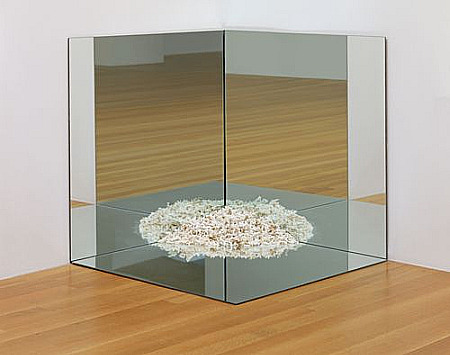
Robert Smithson: Corner Mirror with Coral, 1969. At P.S.1, the sculpture is displayed on a low platform, instead of directly on the floor as originally.
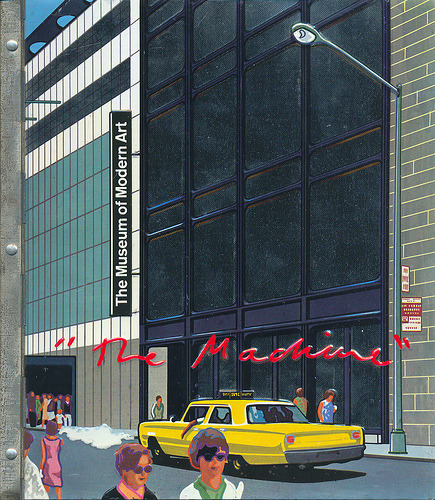
Upon the Arbitrary Nature of Posterity
A yellowed clipping from the Village Voice is included in one of the display cases in the exhibition "1969" at P.S. 1 (Queens, to April 10, 2010). It is my Village Voice report concerning the Takis Fracas at MoMA in '69. The Greek kinetic-artist Takis, objecting to the inclusion of his work, physically removed it from the exceedingly dull exhibition "The Machine as Seen at the End of the Mechanical Age" and had a one-man sit-in in the MoMA garden. The deep question, as far as I know still not resolved in the U.S.A., is one of "moral rights." Does an artist have any claim on an artwork after it has been sold? In Artopia, we say, yes; a thousand times, yes. But as we shall see, in 1969 one thing lead to another. And another....
"1969" (which does not include an artwork by Takis) is a fill-in exhibition in these hard times drawn from the MoMA permanent collection and archives, all works and ephemera dating from that year. If it were not for some contemporary "interventions," this curiosity would be a waste of time, since no new or serious interpretations are offered. Much of the art is familiar.
Mel Bochner's room, Theory of Painting (paper and paint on the floor, words on the wall) is, however, a pleasant surprise, balanced (I suppose) by the disappointing Fluxus multiples. I have to remember what used to put me off about Fluxus - George Macunias' little Fluxus boxes. The Events and the ideas and not the multiples are what's worth thinking about.
How I hate the once-cool term "interventions." Now it just reminds me of the Italian euphemism for surgery.
Nevertheless, multi-media "interventions" (the term used in the press release) by The Bruce High Quality Foundation add zing, ping, and zap to this otherwise curiously forlorn array of once-powerful minimalist and conceptual artworks drained of all energy. I liked a lot of the work way back when and said so, moved on to other things, and now value the work again.
At least until last week.
It may be that these artworks were once effective because of what they were not. They were not Abstract Expressionism, they were not Pop Art, they were not Academic Realism -- but became the latter, in a manner of speaking. Stranded in the unhallowed halls and former classrooms of P.S.1, they are texts without a context.
Designated "museum portals", the BHQF grimy rock-concert speaker (The Creative Society - After Ronald Reagan), the funky BHQF refrigerator (Hell Freezes Over) and the high-use industrial vacuum (We Didn't Start the Fire), through video and sound add the context that the Wikipedia (I kid-you-not) timeline in the hallway does not.
* * *
By the way, the BHQF collective is -- according to Roberta Smith in the Times --- made up of former Cooper Union students of Hans Haacke.They also recently offered a presentation as part of RoseLee Goldberg's month-long Performa 09. The festival, supposedly focusing on performance art, includes film, dance (Anna Halprin, Debora Hay, Yvonne Rainer) and what have you, in honor of the 100th anniversary of F. T. Marinetti's Futurist Manifesto. If you are not motivated to follow this link, here, let me offer a sample and a reminder:
We want to glorify war - the only cure for the world - militarism, patriotism, the destructive gesture of the anarchists, the beautiful ideas which kill, and contempt for woman.
I assume that one or another of the lectures or Performa panel discussions will bring up Marinetti's friendship with and affection for Mussolini. Goldberg does not in her textbook Performance Art: From Futurism to the Present. Michael Kirby does in his 1971 Futurist Performance, but explains it away by stating that the value of art has nothing to do with the political beliefs of the artist: "Great art is not necessarily produced by heroes, nor are 'villains' unable to create major works." Sounds a bit like a defense of all those Commie artists during the McCarthy period, but applied to a Fascist.
Can we be inspired by Futurism and close our eyes to Marinetti's active support of Fascism? In France, during the Occupation, Jean Cocteau collaborated with the Nazis by, among other activities, writing a laudatory catalog essay about Hitler's favorite Nazi sculptor, Arno Breker. Although Breker had once been Cocteau's lover, can we look at Beauty and the Beast in the same way again?
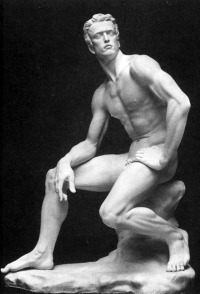
Arno Breker: Predestination, 1940-41
Can we subscribe to Martin Heidegger's Being and Time knowing he became a member of the Nazi Party in 1933? Do we more than wince when we are reminded that our revered Henri Matisse sold paintings to Gestapo officers?
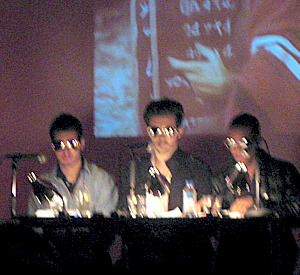 In the meantime, The BHQF presented, in the former Dia Foundation lobby, a slide lecture about sex and art patronage, down through the ages. Those in the know, know that the Dia - planning to return, its absence from Chelsea long lamented -- was founded by Schlumberger (pronounced Schlum-bear-jzhay) oil-equipment heiress Phillippa de Menil and her husband the German art dealer Heiner Friedrich.
In the meantime, The BHQF presented, in the former Dia Foundation lobby, a slide lecture about sex and art patronage, down through the ages. Those in the know, know that the Dia - planning to return, its absence from Chelsea long lamented -- was founded by Schlumberger (pronounced Schlum-bear-jzhay) oil-equipment heiress Phillippa de Menil and her husband the German art dealer Heiner Friedrich.
The three anonymous young men of The Bruce -- wearing aviator sunglasses, and two out of three clad in leather jackets -- sat at a table in front of the audience, taking turns reading items concerning the relationship between sex and art patronage, down through the ages. Slide projections above them were illustrative or sarcastic.
Just when I thought I had had quite enough, they stopped dead. Pause. The images were repeated and began melting together, and there was the thump of a dance rhythm. Without missing a beat and without getting up from their seats, they began singing a kind of Po-Mo-Town ditty. Writing in my notebook in the dark, the words I caught were: I will be your husband; I will be your wife; I will take care of you the rest of your life.

Hans Haacke: News, 1969. Not in MoMA collection; not in exhibition. See note at the end of this essay.
Back at School
The curators of "1969" do not claim their offering of mostly minimal and conceptual art is the be-all, end-all survey of late '60s art, but the naïve might take it as such. It certainly displays what is now a rather safe taste. There's a new game called The Curatorial Detective; you have to guess what graduate art history program any curator in question attended and what old issues of Artforum were memorized.
The artworks indeed were all made in 1969 but were not necessarily accessioned in 1969. Accession dates are not included on wall labels, but if you go to the MoMA website and click on "collections" with the knowledge that accession numbers end with the date of accession, you can find that Richard Serra's Cutting Device was garnered (from Philip Johnson) in 1979; Smithson's Corner Mirror with Coral in 1991; Mel Bochner's Theory of Painting in 1997; Bruce Nauman's Pacing Upside Down and Manipulation of a Fluorescent Tube only in 2008. And, all the Fluxus material only arrived this year. MoMA, it turns out, was not particularly prescient; in fact, it was sluggish in those ancient times when William Rubin was head of the painting and sculpture department and Bates Lowry was the director. Hopeful this exhibition is only the first step in catching up and catching up fast. MoMA in 1969 was not only rude to artists, it was asleep.
Curiously enough, Carl Andre's lead floor-piece made in 1969 was added to the collection that year -- when his name was one of three on theTakis Fracas, anti-MoMA list of demands. For the current foray into "art history", the curators had to substitute a similar piece, borrowed from the Paula Cooper Gallery. Is MoMA's Andre damaged? On loan? Or is this because P.S.1 is not climate controlled and lead is affected by steam heat?
The secret is out. The lack of climate control precludes the MoMA loan of certain fragile works, even to its own affiliate. Thus newcomer Stephanie Syjuco was able to offer amusing versions ("resuscitations" she calls them ) of a Joseph Beuys sled and a Robert Morris anti-form, felt wall-hanging, the originals too fragile or fugitive to face the unfiltered, humid air in Queens. Back in Alanna Heiss days, when I curated "Pattern Painting" for P.S.1, we didn't give a thought to climate control. Of course, there was nothing in my exhibition made of felt. Or fat.
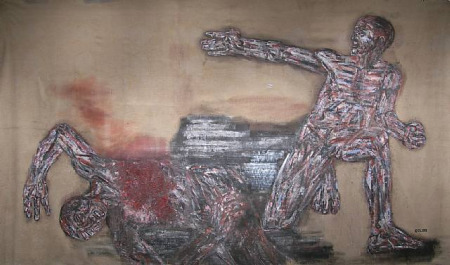
Leon Golub: Napalm I, 1969. Not in MoMA Collection; not in exhibition.
Mysteries of "1969"
A video played on a monitor placed directly on the floor of one of the main rooms will stop you in your tracks. In contrast to Andy Warhol's Blue Movie, in a room to itself with a sign warning that it might not be suitable for children, East/West has no warning that it might not be suitable for adults. It is a 20 minute conversation between Robert Smithson and his wife Nancy Holt.
The interrogation by Holt could cause you to conclude she was the most irritating woman alive and Smithson a cowboy poseur, which I can testify he was not. In fact he was rather serious and certainly intelligent. Were these two satirizing Warhol's movies?
Along with the inclusion of this unfortunate tape, there are other mysteries.
It is very mysterious to me why a Helen Frankenthaler painting is included. In the present company it looks like a cloud of expensive perfume. It does not even provide adequate contrast to the severity that is otherwise here in such abundance but serves to remind this viewer that Frankenthaler - daughter of a Supreme Court judge, wife of Robert Motherwell, and darling of Clement Greenberg --- was one of the N.E.A. committee members dead set against grants for individual artists, which were then forbidden.
Puzzling in a lesser way is the inclusion of four West Coast pseudo-minimalist artworks by Larry Bell, Ron Davis, Robert Irwin, Craig Kauffman, and John McCracken. Pretty is good, but not here.
But the biggest mystery of all is why 1969 is the year of choice, rather than 1968 or 1970........So below you will find my 1969, an indication of what I was writing about in my art columns for the Village Voice in that year
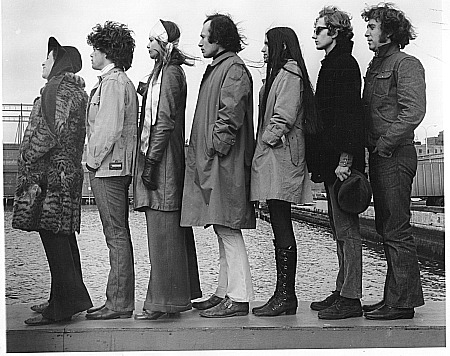 :
:
Hannah Weiner, Scott Burton, Anne Waldman, Vito Acconi, Berndette Mayer, Eduardo Costa, John Perreault Theater Works, Hunter College, 1969. Not in MoMA collection; not in exhibition. John Perreault Archive
Walking Backwards Into The Future
When I first heard of the "1969" show, I wondered if it would include attacks on MoMA made during those heavy-duty times. Past mistakes and stupidities are part of history, right?
There are Art Workers Coalition materials, and, yes, my Voice column about the Takis Fracas is on display. Housed in one of the several library cases, it is suitably difficult to read.
Curious, I later searched out my file of Xeroxes (!) of old Voice pages to see what I had written. Kind of jazzy, and, of course, on the right side--the artist's side. This lead me to look at all the 1969 columns.
Guess what? For the would-be time-traveler or the art historian or for any interested party these pages offer a better picture of art in 1969 than the exhibition at P.S.1./MoMA.
In this regard, I remember at the time being introduced to an extremely pretentious and inordinately pompous art critic (no, not Rosalind Krauss) when said writer returned from Paris "for the first time since the war," said my sarcastic friend, "the first World War."
Her first and only question to me was: "Well, Jean Perreau" (calling me by my father's first name and giving my last name the French pronunciation, "How does it feel to be the most read art critic in New York?"
I corrected her. I said that Hilton Kramer in the Times was the most read art critic in New York, but I was the most trusted and the most influential.
She simply could not understand this, and thereafter I was ignored.
How I Became Famous

John Perreault: Alphabetical T-Shirts, "Street Works IV", Architectural League, 1969. Not in MoMA collection; not in exhibition. John Perreault Archive.
The Village Voice, January 9, 1969: Whose Art?
Report of the Takis 'action' at MoMA. Dissatisfied with the selection and placement of his sculpture (owned by MoMA) in the "Machine Art" exhibition, Greek artist Takis, after receiving no response from the curator or the director, physically removed his piece from the exhibition and sat down with it in the Museum garden in protest......[ I did not report that Hans Haacke was also put off by the treatment of his condensation piece in the MoMA exhibition. His request that the museum leave his artwork plugged in overnight, was ignored. Consequently, the element that was supposed to build up ice never did so. Or rather, what ice had built up from the steam during the day, melted at night. He also had no response from curators, staff, or even the director of the museum.]
The Takis action raised the issue of artists' rights in regard to sold artworks --as far as I know, not yet resolved -- and started a series of artists meetings that lead to more general demands: minority representation, a free day at MoMA, etc. And then the founding of the Art Workers Coalition, itself leading to the Art Moratorium in May 1970.
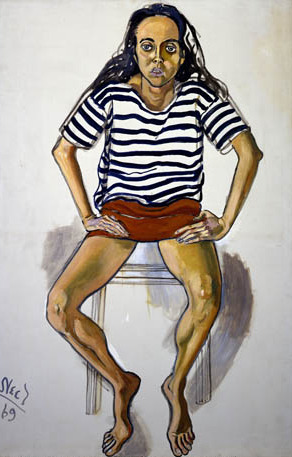
Alice Neel, Ginny in Striped Shirt, 1969. Not in MoMA collection, not in exhibition.
The Village Voice, February 20, 1969: Lies that Are True.
New paintings by Alan D'Arcangelo.
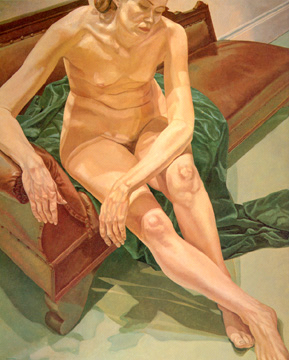
Philip Pearlstein: Nude on Couch, 1969. Not in MoMA collection; not in exhibition.
The Village Voice, February 27, 1968: Earth Show
Detailed report of junket to opening of "Earth Art" at Cornell University. On the plane: Hans Haacke, Les Levine, Neil Jenney, gallerists John Gibson and John Weber, Willoughby Sharp (curator of the exhibition), Lucy Lippard, Dore Ashton (Arts Magazine), John Margolies (Architectural League), Dan Graham, David Bourdon (Life), Max Kozloff (The Nation), Howard Junker (Time) And, of course, yours truly (Village Voice, Paris Match). Praise and description of works by Richard Long, David Medella, Michael Heizer, Robert Morris, Gunther Uecker, Robert Smithson, Hans Haacke, Neil Jenney, Dennis Oppenheim, Jan Dibbits.
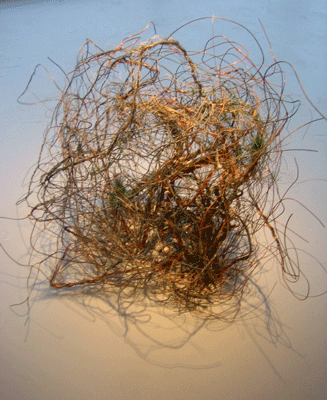
Alan Saret, Untitled, 1969. Not in MoMA collection; not in exhibition.
The Village Voice, March 6, 1969: Outside the Museum
Richard Long at John Gibson; Malcolm Morley at Kornblee; Hairy Who at SVA..
MoMA's response to artists' demands: a committee on artists relations to receive complaints and make recommendations. Rejected. Takis supporters increase to 30.
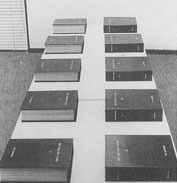
On Kawara: One Million Years, 1969. Not in MoMA Collection; not in exhibition.
The Village Voice, March 13, 1969: Off The Wall
Seth Siegelaub's One Month (publication-as-exhibition): Joseph Barry, James Lee Byars, Douglas Heuber, Dennis Oppenheim, etc. Also: Robert Morris at Castelli Warehouse---Continuous Project Altered Daily.
The Village Voice, April 3, 1969: Back Indoors.
Barnett Newman's first exhibition in 12 years. Charles Sheeler. Nancy Graves. Paul Thek's Fishman.
The Village Voice, April 19, 1969: MoMA and the Workers
"The Museum of Modern Art seems to have been playing a waiting game...."
Art Worker's Coalition formed....."The initial negotiations and confrontations were handled very badly, so much so that I that I felt it necessary to withdraw my de Kooning lecture as a protest...." Two anti-MoMA demonstrations....Director Bates Lowry to the New York Times: the public hearing and free admissions "were absolutely impossible and can't be considered"....Art Workers Coalition has an open hearing at the School of Visual Arts. Lowry, after less than a year as director, resigned in May 1969.
Philip Pearlstein at Frumkin..."perhaps the most radical of all the new representational painters." .....Robert Huot at Paula Cooper...installation and luminactive tape; Richard Long at Bowling Green.
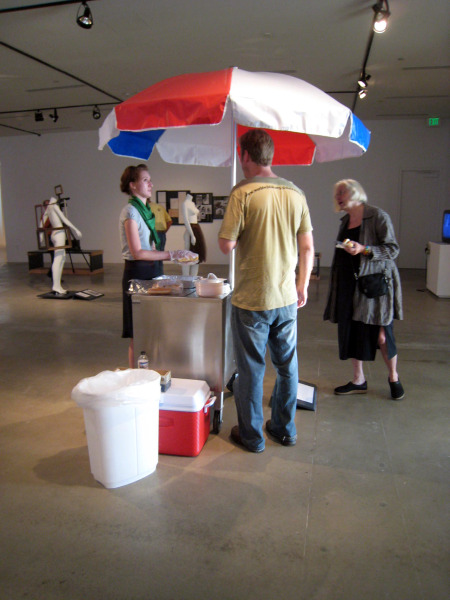
Hannah Weiner: Weiner's Wieners, 1969. Street Works IV. Recreated in 2008 for "In Plain Sight: Street Works and Performances 1968 -1971," The Laboratory for Art and Ideas, Belmar, Colorado. Courtesy: John Perreault Archive.
The Village Voice, May 1, 1969: Free Art
Street Works I. Initial group (Hannah Weiner, Marjorie Strider, and John Perreault) expanded to include: Vito Acconci, Eduardo Costa, Bernadette Mayer. Twenty artists actualized streetworks on March 15. Founders, plus Scott Burton, Arakawa, John Giorno, James Lee Byars, Bernar Venet, Gregory Battcock etc. [Three Streetworks announcements are included in the "1969" exhibition ]
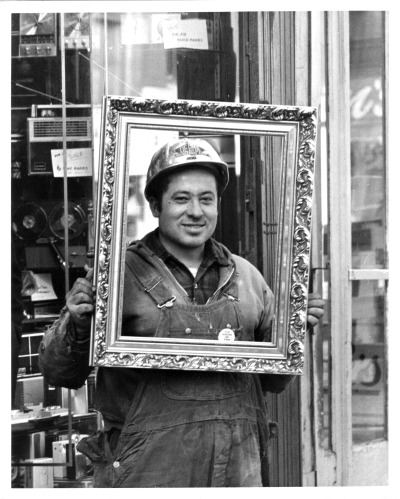
Marjorie Strider: Street Work, 1969. Not in MoMa collection; not in exhibition.
The Village Voice, May 8, 1969: Visual Pleasure
Nicholas Krushenick paintings. David Hockney. Robert Ryman.
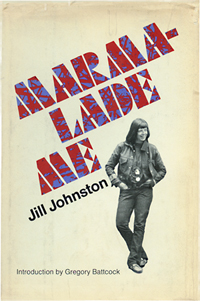
The Village Voice, May 29, 1969: A Sort of Sacrifice.
"The Disintegration of a Critic: An Analysis of Jill Johnston," a panel discussion at N.Y.U. David Bourdon (moderator), Charlotte Moorman, Gregory Battcock, Ultra Violet, Bridget Polk, Walter Gutman, John de Menil, Lil Picard and Andy Warhol. With an appearance of Ms Johnston in rage mode protesting how her Village Voice column had been cut and then reading the very long discarded section, finally to much applause...Also: Discussion of Anti-Illusion: Procedures Materials at the Whitney. Description of and praise for works by: Richard Serra (lead splash piece), Carl Andre, Bruce Nauman, Neil Jenny but "he should have eliminated those hideous acrylic paintings and just shown the bowls of dog food."), Robert Morris, Bill Bollinger, Eva Hesse, Rafael Ferrer, Michael Snow...

John Perreault: Hair Veil (fromFashion Show Poetry Event),1969. Center for Inter-American Relations. Artist and model (Anne Waleman). Not in MoMA collection; not in exhibition.
John Perreault Archive.
The Village Voice, May 22, 1969: Invisible Dancers
Spring Gallery '69 @ Paula Cooper Gallery. Performances by Marjorie Strider by Tom Gormly, Hannah Weiner plus a dance piece by Deborah Hay ["Performances" first used by Pop artist Strider, who had been in some Oldenburg Happenings and had been married to Michael Kirby, author of the first book on Happenings}.......Mentions of shows by Lowell Nesbitt at the Stable Gallery; Jasper Johns and Robert Rauschenberg at Castelli, Jack Kruger's 100 piece sculpture at Castelli Warehouse, a show of erotic drawings called "Censored" at Cannabis. Also Aesthetic Realists Chaim and Dorothy Koppelman: "Their petition to gain a review from the Times quotes Hilton Kramer as saying he'd 'puke' if he got another telephone call from them. I know what he means." Also: "my apologies to Abraham Lubelski: I erroneously reported that his patch of grass in Street Works II was fake. It was real grass."

Chck Close: Frank, 1969. Not in MoMA collection; not in exhibition.
The Village Voice, June 5, 1969: Para-Visual
"Language III" at Dwan Gallery. Lucy Lippard's Art Workers Coalition Benefit at Paula Cooper. Hans Haacke, Bernar Venet, Richard Artswager (Blips), Carl Andre, Lawrence Weiner, Sol LeWitt, Bill Bollinger, Robert Smithson, Mel Bochner, Michael Kirby, Joseph Kosuth, Adrian Piper, On Kawara, Robert Morris, Bruce Nauman. Kosuth's instruction piece was to go to the Dwan show and separate the art from the poetry.....Street Works III: Soho at Night: 500 participants.... "New Works" by Acconci, Arakawa, Perreault, and Venet.
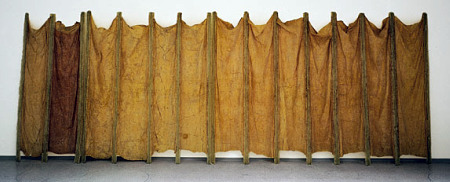
Eva Hesse: Expanded Expansion, 1969. Not in MoMA collection; not in exhibition.
The Village Voice, April 24, 1969: I Never Saw a Purple Plane
Trip to Ohio: "Before my departure from Ohio, I remember sitting in the Zane Gray Room of the Zanesville Ohio Holiday Inn near the Zane Line, eating my Zanesville Steak, joyfully contemplating my return to New York and the resumption of my quest for the perfect painting on velvet (preferably of a kitten), the perfect clown portrait, the most voluptuous Abstract Expressionist smudge or splatter, the tackiest vanity gallery, and the rudest and/or pushiest artist."
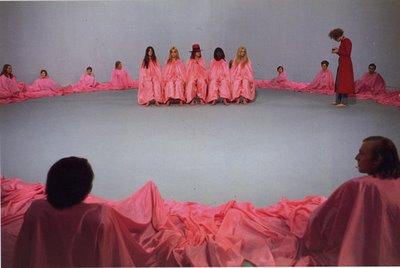
James Lee Byars: The World Question Center, 1969. Not in MoMA collection; not in exhibition.
The Village Voice, October 2, 1969: Other Things and Lichtenstein
Roy Lichtenstein; Iowa City teaching gig; Smithson "Urination Piece."
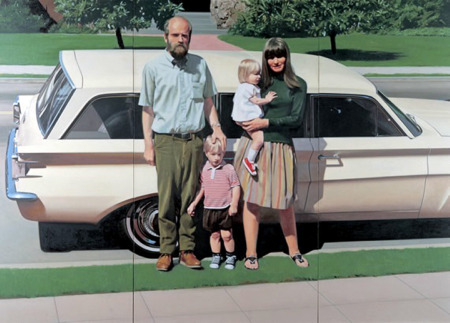
Robert Bechtle: 1961 Pontiac, 1969. Not in MoMA collection. Not in exhibition.
The Village Voice, October 9, 1969: Looking For Art
"...although I did manage to see a few interesting things in the galleries, the things that really stick in my mind are Godard's Le Gai Savoir at the Film Festival--it was more visually stimulating and 'plastic' than most of the gunk I see in the galleries....Wednesday I trekked up to Charlotte Moorman's [avant-garde] festival, but didn't see very much. Missed Lil Picard wrapping people up in bedsheets.....
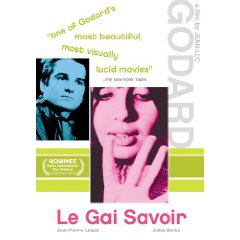
The Village Voice, October 16, 1969: Taking to the Streets.
"Street Works IV," sponsored by the Architectural League: Vito Acconci, Arakawa and Madeline Gins, Scott Burton, Eduardo Costa, John Giorno, Stephen Kaltenbach, Les Levine, Abraham Lubelski, Bernadette Mayer, John Perreault, Marjorie Strider, Hannah Weiner.
The Village Voice, October 23, 1969: The Monet of Minimalism
Sol LeWitt wall drawings.
The Village Voice, November 6, 1969: Treasure Hunt
Art junket to Andy Warhol's "Raid the Ice Box" exhibition in Houston. Details of shenanigans in the de Menil private jet: "We even took turns reading aloud Annette Michelson's review of John Russell and Suzi Gablik's Pop Art Redefined. ....Miss [sic] Michaelson's piece, which appeared in the New York Times Book Review, was not exactly easy going and was full of affectations, quirks, and oblique references."
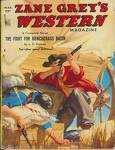
The Village Voice, November 20, 1969: Systems.
Hans Haacke at Howard Wise; Deborah Remington at Bykert; Mon Levinson at Kornblee; Les Levine's "Your Worst Work" at the Architectural League; Peter Hutchinson and Dennis Oppenheim at MoMA; Jean Dubuffet at Pace; Lucy Lippard's "Groups" at SVA Gallery; Gary Kuehn at Fischbach; Peter Saul at Frumkin.

Keith Sonnier: BA-OH-BA, 1969. Not in MoMA collection. Not in exhibition.
The Village Voice, December 4, 1969: Plastic Very Present
"Plastic Presence" at the Jewish Museum. Pan, but praise for Eva Hesse and Frank Lincoln Viner, and Richard Van Buren......Burgeoning of Soho galleries....Meeting with Lygia Clark during her first visit from Brazil: "...now almost totally concerned with touch...For one work, I had to blow up a plastic baggie. She then closed it with a rubber band and placed the bag inflated with my own breath, in my hands, dropping a smooth onto the top of it. The stone, which could be made to move by manipulating the plastic bag as I squeezed it, seemed to be floating within the clear plastic bag. I was holding my breath and my breath was holding up a stone...."

Lygia Clark: Untitled (participation piece), 1969. Not in MoMA collection. Not in exhibitiom.
The Village Voice, December 18, 1969: Get The Picture?
Discussion of photography and art. "Painting from the Photo" at the Riverside Museum. Artists discussed: Richard Estes, Malcolm Morley, Joseph Raffael, Harold Bruder, Audrey Flack, Howard Kanovitz. [Louis Meisel had not yet invented the term Photo-Realism.]
Also: "I have been receiving the Wall Street Journal every morning courtesy of Bernar Venet. Stock market figures and weather reports have been Venet's special thing for awhile now, so I guess this is a work of art....."
Penultimately: "At the ICA panel discussion in Philadelphia called "What Happened to the '60s?" Les Levine took James Lee Byars' edible paper man that we were supposed to [give] to the audience to eat and dissolved it in a pitcher of water. Jill Johnston read from her memoirs [about being a lesbian dance critic and the illegitimate daughter of the poet Apollinaire], Warhol sent critics Gregory Battcock and David Bourdon to Paris for a Thanksgiving dinner."....
Finally: "In a recent program at the Emanu-el Midtown Y, Vito Acconci sat in front of the audience and stared at each person for 13 seconds. He then climbed up and down off a box for one half hour, repeating this three times in his apartment, with the end result, as expected, that he cold not walk at all the next day."
Note: Most of the images I have used, as indicated, are of artworks not in the MoMA collection and not in the exhibition. This is to illustrate (1.) the near-absurdity of the theme; (2.) the possibilities of other samples from 1969, particularly outside the MoMA collection; (3.) to give a richer picture of that year which was no less chaotic and no less aesthetically diverse than any other year; (4.) and, more personally, to indicate my Village Voice columns were hardly every illustrated with art mentioned in the text; the photographer chose the pictures, for whatever purpose.
Also, I first tried formulating an alternative exhibition by going to the online version of the MoMA collection on their website, learning that, given the material, the curators probably did the best they could. My "Googled 1969" had other problems. You have to know in advance what artists you are looking for and most images, alas, do not include dates or titles. Many artists have simply disappeared or only exist outside of cyberspace, perhaps because they have sold every piece they ever made and did not retain reproduction rights or fear appropriation for commercial purposes.You should be so lucky. Artists, get over it. The virtual museum is already here. As they used to say in 1969, go with the flow,
FOR AN AUTOMATIC ARTOPIA ALERT: perreault@aol.com
John Perreault is on Facebook.
You can also follow John Perreault on Twitter: johnperreault
MORE: www.johnperreault.com
What do these images have in common?
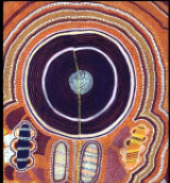
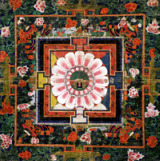

Top left is from "Icons of the Desert: Early Aboriginal Paintings from Papunya"
at the Grey Art Gallery, N.Y.U., 100 Washington Square East, to Dec.5.
Top right is from "Mandala: The Perfect Circle: at The Rubin Museum, 150 W. 17, to Jan. 11.
Lower middle is from "The Red Book of C. G. Jung" at The Rubin Museum, to Jan. 25.
Codes, Maps, and Building Plans
Some images and objects we can only see as art by separating them from use, and, therefore, since use is meaning, separating them from meaning. This is not necessarily to fulfill some dubious agenda that defines art as form alone. It may be because we do not understand or want to understand the use intended or have no way of experiencing the belief required.
We are expected to appreciate cathedral décor whether or not we subscribe to Christianity. So if we forgive da Vinci (and, let's face it, Chagall -- whose work has some relationship to Judaism or Kandinsky who was Theosophical) then why shouldn't we make allowances for Australian Aboriginal paintings,
The Red Book of Carl Jung, and Tibetan mandalas. Most of us do. But should we?
In ancient times -- you know, like the Sixties --I was accused of at least three sins. "John," said one artist friend, "I love your writings, but you are always solving problems I didn't know I had." And then, from another: "You are always arguing with yourself." Finally, proclaimed another artist friend: "You are always writing about yourself," meaning, I still think, instead of writing about me.
The first is the critic's duty, which is to see what the artist is not aware of and to say what the artist cannot say. The second objection is also based on ignorance, but ignorance of the dialectical mode of expression. The third objection can only be answered in terms of the rhetorical disclosure of the personal as a sign of the instability of any statement. Unlike the royal "we," the first person in criticism reveals the possibility of bias in all writings, which is why it is usually forbidden. The author is not hidden. It is also an easy way to
include a wide range of material
Teaser: I am thinking of the Sixties because of "1969" at P.S. 1, but I hope to get to that exhibition, if only briefly, next time around. After all, I am in it, right?
In the meantime, I hope I am still solving problems you didn't know you had. The problems you know you have are most likely already solved. And nothing has changed, has it?
In regard to the second objection, I wonder what that artist would now think of my current writings, since herein the dialectical has been superceded by the braided.
In regard to the third objection, the only thing I would add now is the clarification that the first person is as much a fiction as the third.
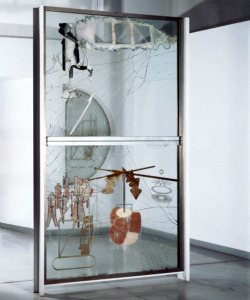
But Is It Art?
Here I want to make the case that we should not look at Australian Aboriginal paintings, Jung's visionary drawings (1902-1913), or Tibetan mandalas as art, for to do so is reductive.
Yet so much depends upon Marcel Duchamp. Both The Bride Stripped Bare by Her Bachelors, Even (1925-23) -- see above illustration -- and Given: 1. The Waterfall, 2. The Illuminating Gas... (1946-1966) are so opaque they seem to be resultants of alien equations, obscure investigations, secret rituals, maps of other states of consciousness.
This too is the charm of the Aboriginal paintings now at the Grey Gallery, the Tibetan Buddhist mandalas at the Rubin Museum, and the images from Carl Jung's long-suppressed record of his possibly transcendent ego-trip.
Because the forms in each of these exhibitions are determined by extra-aesthetic motivations and/or content is why they are so vital. They really are derived from alien equations, obscure investigations, secret rituals, maps of other states of consciousness. The forms, splendidly anti-compositional, could not be arrived at any other way. They were generated by other than aesthetic means.
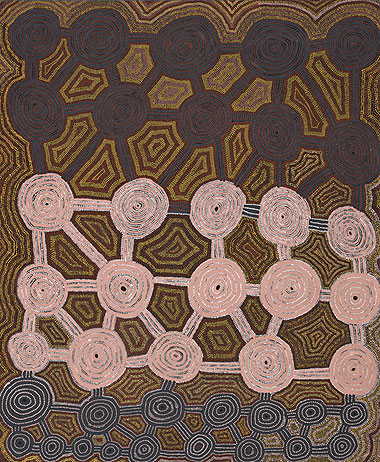
Down Under
I knew of the Aboriginal paintings much before I visited Australia, but once there as Guest Professor of Something or Another in the capitol city of Canberra, I could not avoid them. They are even depicted on postage stamps. There are now as many Aboriginal artists as there are Euro-Australian ones, which means there is a higher percentage of Aboriginal artists within the indigenous population than the percentage of artists among the Euro-Australians. This does not mean that the art market has solved the poverty problem for indigenous peoples of the sub-continent. Art projects rarely solve economic problems, particularly ones based on colonialism and racism. Nor does it explain why some "dot paintings" go for more than any white Australian equivalent. The latter, however, explains why there are so many fakes.
After my teaching stint - punctuated by several trips to beautiful Sydney and a quick visit to my hero "Such is life" Ned Kelly's jail cell in Melbourne - I felt I had to visit sacred Uluru, dead center of the Australian desert. I needed something to balance Kelly's gallows irony and the fact that he, as the Australian Robin Hood, arranged that the mobs of well-wishers at his public hanging receive free press-photos of his Irish bandit-visage.
We flew to Alice Springs and then drove along that same straight-edge, one-lane, unpaved highway we had seen from the air, all the way to the Aboriginal sacred rock, once briefly known as Ayers Rock by the white guys. Although now surrounded with three rings of tourism, Uluru mysteriously still glows purple at sunset. There are three-tiered accommodations: Luxury Hotel, Mid-Range, and Camp Ground. And yet....I still felt I was on another planet. The indigenous peoples are right: this is a sacred place. I circumambulated the rock, or at least dreamed I did.
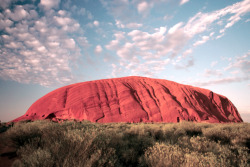
I didn't realize it at the time, but 150 miles from Alice springs on the Papunya reservation was where the dot-paintings began. They were sparked by the non-Aboriginal schoolteacher Geoffrey Bardon in 1971.
Mick Namararri Tjapaltjarri (1927-1998), Uta Uta Tjangala (1926-1990), Johnny Warangkula Tjupurrula (1918-2001) and other talented "artists" took to using acrylic, on boards and then on canvas. Herded together from different tribes, they embraced both the opportunity of giving voice to their 30,000-year-old (!) cultural traditions and the possibility of some ready cash.
Although at least once-removed from their origins in the story-telling, ground painting, body painting of the ineffable Dreamings, the paintings now at the Grey Gallery possess some of that numinous, unearthly aura that spooked me out at Uluru. Dreamings, after all, are one-part deed-keeping, one-part mapping, one-part conjuring, one-part creation myth.
The credentials of the works at the Grey Gallery are impeccable. They are from the first 1000 Aboriginal dot paintings ever made. All were painted at the beginning of the art movement and pretty much before tribal elders grew increasingly insistent that secret, sacred imagery be fully disguised by dots. It is ironic, therefore, that the works are sometimes known as "dot paintings" - i.e. paintings that feature imagery that has been erased.
Some of these diagrams or maps, like the illustration above, are still taboo for aboriginal women and children and are so-designated at the Grey Gallery, where such are grouped in the lower gallery. The images are ports of entry for ancient entities. The gendered nature of the Dreamings --- a bad translation of an Aboriginal term for timelessness -- suggests their initiatory character.
Tibetan mandalas can take the form of temporary sand paintings. Surprisingly far from Tibet, the Aboriginal paintings are inspired by indigenous sand-paintings, which, in turn, relate to mandala-like Native American ground-works.
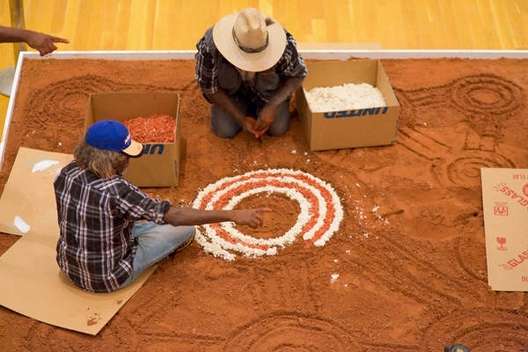
Aboriginal ground-painting being made for opening of "Icons of the Desert," Johnson Museum, Cornell Univeresity. Earth, dye, dried flower petals.
![]()
Finished ground painting...image courtesy Ithica Journal.
Carl Jung would have been pleased by these synchronicities, but he would also have been pleased by more evidence of gender-divisions in the realm of the spirit, the perpetuation of which was one of his personal, very deep flaws. The man, as you shall see, had problems.
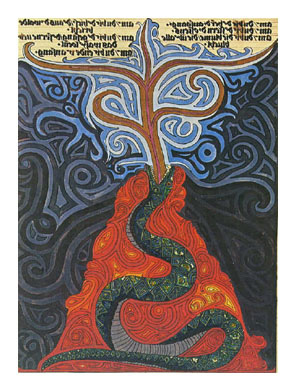
Too Jung, Too Foolish
C. G. Jung's The Red Book (1913-1916) has been suppressed until now. An expensive facsimile edition is now available from Simon and Schuster. Pages from this facsimile and other documents make up an exhibition at the Rubin Museum. At first one might wonder why a museum devoted to the art of the Himalayas would have an exhibition center around an early hand-calligraphed notebook by Carl Jung. But, don't worry, this too shall be clarified.
Apparently Jung's family and other interested parties thought The Red Book would put him and his discoveries in clinical psychology or depth psychology in a bad light. And yet Jung himself said it was during the strange, inward-looking period of The Red Book that he came across all the ideas we know think of as Jungian. Everything can be traced back to his scary experiment, probing or yielding to his own troubled depths. His idea of scientific research was to turn in on himself.
Some related material now on display at the Rubin are pencil-drawings of mandalas he made in 1917, when, as he himself later wrote, he found his anima, or, to simplify, his feminine side. "She" was not all sweetness and light. She - everyman's Lilith - never is. To some she may be Beatrice, but to Jung she was -- although he did not call her that -- Kalachata's Vishvamatr, but not so much as an embodiment of bliss, but rather as the personification of Kalachata's wrath. And yet the anima is also supposed to be the embodiment of every male's repressed spirituality. Who said Jung indulged in simplifications?
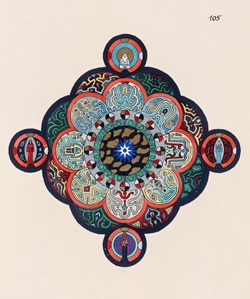 About his own mandalas he wrote:
About his own mandalas he wrote:
"My mandalas were cryptograms concerning the state of the self which was presented to me anew each day...I guarded them like precious pearls....It became increasingly plain to me that the mandala is the center. It is the exponent of all paths. It is the path to the center, to individuation...."
Jung's journey was the Orphic descent. If he had been more cognizant of Islam, one wonders if he would have had a Mohammedan ascent instead.
Are these pages art? Oh, no. In spite of the careful, obsessive calligraphy and the tidy pictures in the he Red Book were not intended as art.
In Memories, Dreams, Reflections (1961), based on extensive interviews, Jung recounts his encounter with his anima and her insistence that what he was doing in his notebooks was art. "I said very emphatically to this voice [that of his anima] that my fantasies had nothing to do with art...No, it is not art! On the contrary, it is nature."
Further:
The anima might then have easily seduced me into believing that I was a misunderstood artist, and that my so-called artistic nature gave me the right to neglect reality. If I had followed her voice, she would in all probability have said to me one day, 'Do you imagine the nonsense you're engaged in is really art? Not a bit.' Thus the insinuations of the anima, the mouthpiece of the unconscious, can utterly destroy a man.
Now, I must admit, that unless you are attuned to Jungian prerogatives, to the tempting revelations of the Gnostic heresies, to Sixties New-Age ways of thinking, and to non-western spiritual traditions, you may find this material, if not extremely iffy, then totally insane.
I quarrel with Jung's quaint insistence upon radically different male and female souls. Excuse me. In my experience, women simply are not more spiritual than men, nor are men more logical than women. Jungian individuation may involve a symbolic androgyny, but this in Jung's theology is built upon a sexual dualism that is untenable.
Nevertheless, in Artopia we understand that Jungian therapy - and it's world-view - leaves more room for art than does Freudian psychoanalysis. Jung opened up new paths of inquiry and almost became the magus he thought he was. After personalizing and getting his anima under control, Jung delved into alchemy and the Kabbalah, as well as the I Ching and the Taoist Secrets of the Golden Flower. The woman who owned the gallery I showed with in the early Sixties never made a move without consulting the I Ching.
An exhibition such as this quiet display honoring The Red Book - the Jungian Holy Grail -- could force you to delve a bit deeper into Jung, which, I know, you have probably been avoiding. But just try to forget that not only Herman Hesse but also Jackson Pollock underwent Jungian therapy.
Peeling back the layers of time, you had also better be careful when you read about the Buber/Jung controversy. Nowadays perhaps better known as a champion of Hasidic mysticism and the simplifier of the Hasidic teaching-tales then as an Existentialist philosopher, Martin Buber in full philosophical fury accused Jung of being -- surprise! --- a Gnostic. In other words, a dangerous, polytheistic, dualistic heretic out to destroy monotheism. Briefly, Jung was "mystically deifying the instincts instead of hallowing them in faith" and thus promoting "a modern manifestation of Gnosis."
Jung gave empiricism as his self-defense. And then Buber responded to that disengenious claim.
Of course, Buber was right, although he himself seemed to have forgotten that Hasidism is rooted in the Kabbalah, with its suspicious Little Man and Big Man. And, yes, all those emanations and broken vessels. And is the Shekinah not God's partner? Oops.
We have had more than hints of Jung's shamanistic plunge before the publication of The Red Book. Jung's The Seven Sermons to the Dead, written in 1916, has been available in English since 1961 as an appendix to Memories, Dreams, Reflections.
This high-strangeness purports to be a text written by the real-life Basilides, a second-century Gnostic. Although much of it is pompous paradox -- Jung unlike Freud was never a stranger to pomposity --- the effect is hair-raising. It may have been automatic writing and/or dictated by whatever foot-loose and meddlesome spirits were hiding out in Zurich at the time or it may have been pieced together from texts of medieval heresy trials, but Jung was on the same wave-length as the Gnostic texts found at Nag Hammadi, much later. Basilides/Jung even claims Abraxas as the god of this world. Thus this creepy little hymn to dualism begins:
The dead came back from Jerusalem, where they found not what they sought. They prayed me let them in and besought my word, and thus I began my teaching. Harken: I begin with nothingness. Nothingness is the same as fullness. In infinity full is no better than empty. Nothingness is both empty and full....
Well, yes, sort of.

Gemstone with image of Abraxas, one of the Archons, n.d.

Inside A Tibetan Mandala
Onward and upward to the 5th Floor of the Rubin Museum, for a breath of fresh air: The Five-Deity Mandala of Amoghapasha (8-9th Century), The Kalachakra Mandala (c. 1650-1700), and many others plus a pixilated projection of a sand mandala being made, projected horizontally, but minus hands, monks, funnels.
Many years ago I watched a Tibetan sand-mandala being made, and saw it, as is the custom, then destroyed. I also interviewed the Dalai Lama.
As a kid, having read James Hilton's Lost Horizon, I identified with Tibet. An important character in that fantasy is a priest named Father Perrault, obviously a great-uncle of mine. My last name has been spelled both with and without the second "e." My imagined cousin, movie-star Gigi Perreau, dropped the last two letters. Here is a clip from the wretched 1937 movie version of Lost Horizon that features buildings in Shangri-La obviously, designed by one of Frank Lloyd Wright's lesser students.
Both Father Perrault and Gigi (and soccer stars too numerous to mention) were obviously all descended like myself from Charles Perrault of the court of Louis XIV, first secretary of the French Academy and, more importantly, the transcriber of the Tales of Mother Goose, which include Cinderella, Bluebeard, Beauty and the Beast, and Little Red Riding Hood.There is also the notorious Perreault Gang of Canadian highwaymen, but let's not go there.

Charles Perrault (1628-1703)
Years after my brief encounter with the Dalai Lama, I visited Beatrice Wood - she who had been a cohort of Marcel Duchamp -- at her ceramics studio in Ojai, California. It was and is on land owned by the Krishnamurti Foundation. The woman sometimes referred to as the Dada Mama pointed out the view from her terrace. She was 100 years old. The distance hills, she claimed, had been filmed as the foothills of the Himalayas for the Frank Capra movie version of Lost Horizon ( 937). No wonder I felt at home.
To make a long story short, I have written about Tibetan mandalas before, and, although surprised by several aspects of the current exhibition, I was not planning to write again. Until I realized I had a triple-header on my hands.
The exhibition is, of course, a glorious array, showing some of the earliest mandalas now extant. But what impressed me this time was not so much the paintings on cloth, but the three-dimensional manifestations.
Briefly, the Tibetan mandalas in the Tantric Kalachakra tradition, whether painted on cloth or actualized as ephemeral sand-paintings, are air-views of temples. But these are no ordinary temples. Properly instructed and in the right frame of mind, as you wind your way around the corridors and up the stairways -- circumambulating the center and the pinnacle-- you will get closer and closer to Buddha-hood. Various "deities" will materialize, bur fear not, like everything else in this world, they are only illusions.
Kalachakra and his consort, bright-yellow Vishvamatr are at the center of the labyrinth, male and female united. At this center, which is also the peak of the temple, you will become the Buddha. All of this used to be top secret. However, unlike Aboriginal elders, Tibetan Buddhists have realized that nothing is so secret as what is readily available.
Two three-dimensional mandalas made of metal are at hand. They could be architectural models, but they are much more: aids to helping you visualize your path through flat versions of themselves. If finding your way through the pathways of the mandala is in order to increase your powers of visualization, then isn't a 3-D model cheating? Probably not. As far as I know you are not punished for being a few counts off in your required number of repetitions of the Jesus Prayer --- or any given mantra. Stories too are told of seekers repeating the wrong section of the Talmud or the wrong quotation from the Koran, but still attaining results.
In any case, through these metal "sculptures", you are led to really see that Tibetan mandala "paintings" are not only diagrams of the world, but temples you are supposed to enter. The digital version - which may be cheating to the third degree -- was made as a collaboration between some Tibetan monks and the computer department of Cornell University. It's part of the exhibition. Here is a a version:
Now do you understand it when I say that Tibetan mandalas -- like Aboriginal Dreamings and Jung's illustrations in The Red Book - are not art works? They are spiritual tools.
YOU TOO CAN HAVE AN AUTOMATIC ARTOPIA ALERT BY E-MAIL
CONTACT perreault@aol.com. MORE johnperreault.com
John Perreault is on Facebook.
You can also follow John Perreault on Twitter: johnperreault
